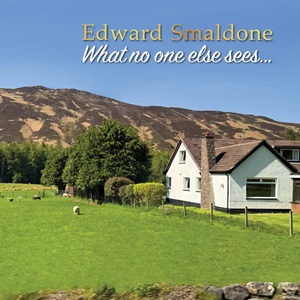
Edward Smaldone (b. 1956)
What no one else sees …
Beauty of Innuendo (2013) ¹
Prendendo Fuoco [Catching Fire] (2020) ²
Murmurations (2021) ³
June 2011 (2011) ⁴
What no one else sees …⁵
Performers and recording details listed after review
Reviewed as download
New Focus FCR 425 [75]
“I’d like to prepare you for this CD with some ideas about three passions of mine: food, music, and architecture”, writes American composer Edward Smaldone in the foreword to this issue, and continues, “You can imagine this CD as a large table filled with musical dishes prepared over the course of 15 years, assembled here in the anachronistic form of a single CD. Think of it as a plate from which to sample from the buffet, returning as often as you like for the complete five-course banquet. I hope your ears and your emotions will be surprised, intrigued, drawn in, fascinated, enticed, tickled, and possibly even shocked from time to time with an array of satisfying and tasty bits.”
As a dedicated omnivore, I approached the buffet with both curiosity and some trepidation. I snapped up, while perusing the rest of the foreword, that Smaldone’s musical household gods are jazz musicians, in particular bebop names like Miles Davis, Oscar Peterson, Joe Pass and others. Also that he has himself been a performing jazz guitarist for fifty years. This is certainly my cup of tea. The other side of the coin is his fascination for dodecaphony, ie. twelve-tone music. I understand the principle and I have no aversions against the dissonances that are an unavoidable result of the technique, but I’m still sceptical. I fully understand that Edward Smaldone, with his interest in architecture, is fascinated by structures. Anyway, when I indulged in the buffet, I certainly appreciated the dishes; I even returned to several of them for a second helping.
My first impression of the opening piece, Beauty of Innuendo, was that here Smaldone wallows in his love of big band jazz: smashing, brass dominated fanfare chords and heavy percussion, really powerful music, but after circa three minutes he changes focus to softer, woodwind chamber music. Then the focus shifts several times, like a dialogue between two antipodes. In the end, it is the woodwind softness that wins the battle and discretely leaves the battlefield.
The piano concerto, Prendendo Fuoco [Catching Fire] from 2020 is the longest piece in this programme. It is written in four consecutive movements, played attacca: Introduction (Smoldering), Ballad (Singing), Fire Dances, Incendiary (Quiet before the storm, Catching Fire). It is initially a rather lyrical work, with a rhapsodic piano part, jazzy with rather jagged rhythms. In the finale, Catching Fire, the soloist has a field day with virtuoso playing of the highest order. It was composed for Swedish pianist Niklas Sivelöv, himself a successful composer, and it was finished in 2020. Then came the pandemic which paralysed the whole world and the planned premiere was postponed until March 2023, when it was performed in New York City with the composer conducting. It was recorded in Glasgow the following year, with Sivelöv playing the solo part.
Murmurations (2021) is the most recent work here and is composed for military band and clarinet soloist, the eminent Dane, Søren-Filip Brix Hansen. There is a mystical atmosphere about the music – hence the puzzling title – but the jazzy atmosphere is there. The solo part is virtuoso.
June 2011 is also strongly influenced by big band jazz, but there are also long stretches of inwardness, referring to the title. That was the month when the last member of the previous generation passed away.
The last work stands out from the rest of the programme in several ways. It was written for woodwind quintet, a glaring contrast to the big orchestral forces of the other pieces. The names of the three movements are straightforward and the whole work was recorded live and presented here without moppings-up or other editing. The title, What no one else sees … is taken from a line in “The Creative Act” by Rick Rubin, a music producer best known for his work with pop and hip-hop artists. It can of course be interpreted in many ways, so the field is wide open for the listeners to create their own visions. The first movement, Playful, is exactly that: a typical scherzo full of joy and syncopated, so jazz isn’t far away here either. The following movement, Serious, is kind of sighing, but in between there are long beautiful cantilenas, while Free Spirited is again rhythmic, full of action; a lot happens in a short time. It is very stimulating, and the Danish Opus Zoo Woodwind Quintet, for whom the work was composed, are really inspired. Exactly when the work was written does not emerge from the text.
My brief comments about the works are not intended to be analyses, just my spontaneous first reactions. For more deep probing descriptions, Edward Smaldone’s own descriptions are a more reliable source. This was my first contact with his music. It was a pleasant meeting, and it was moreish. The harmonies are bold, littered with dissonances, which may be a hindrance for some listeners to appreciate it, but it is worth the effort to give it a try. A good piece of advice to sceptics is to start with What no one else sees … The first movement, Playful, should clear away any doubts.
Göran Forsling
Buying this recording via a link below generates revenue for MWI and helps us keep free access to the site

Performers:
Niklas Sivelöv (piano) ²
Søren-Filip Brix Hansen (clarinet) ³
Brno Philharmonic/Mikel Toms ¹
Royal Scottish National Orchestra/Mikel Toms ² ⁴
Den Kongelige Livgardes Musikkorps/Giordano Bellincampi ³
Opus Zoo Woodwind Quintet ⁵
Recording details:
rec. 2013, Besední dům, Brno, Czechia ¹
rec. 2021, Staernkassen Theater, Copenhagen ³
rec. 2022, Royal Concert Hall, Glasgow, Scotland ⁴
rec. 2024, Royal Concert Hall, Glasgow, Scotland ² and Odense, Denmark ⁵
















